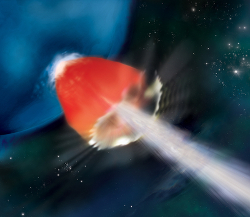 HEAPOW: Metal Poor Burst? (2014 Jul 14)
HEAPOW: Metal Poor Burst? (2014 Jul 14)
Massive stars die in tremendous explosions called supernovae. In the most massive stars, the loss of thermonuclear fuel at the center of the star can cause the collapse of the star's core and the formation of a black hole inside the star. As the newly-formed black hole begins to swallow the star from the inside out, a powerful jet of particles and radiation forms inside the star, blowing the star apart as the jet surges towards the stellar surface. If these beams are directed towards earth, we can detect this event as a bright burst of high energy gamma rays. Roughly one such gamma-ray burst is detected by modern gamma-rays observatories each day. These types of gamma-ray bursts typically last less than a few minutes. But on September 25, 2013, a gamma-ray burst was detected by the Swift Gamma-ray Burst space telescope which lasted neary 2 hours, an "ultra-long" burst. The duration of this burst, and its subsequent X-ray and radio emission, suggests to astronomers that this event must have occured in a very large star, a so-called "blue supergiant". An artist's rendition of a jet bursting through the surface of a blue supergiant star is shown above. Since massive stars shrink over time due to mass-loss from their strong stellar winds, the explosion of a star as a blue supergiant suggests that this star must have had a very weak wind. Since the stellar wind is created by the absorption of the star's intense ultraviolet radiation by iron and other heavy elements, it's believed that the star that gave rise to this gamma-ray burst may have had very few of these metals. Because the first stars which formed in the Universe had no heavy elements, astronomers think that this long gamma-ray burst may provide a glimpse into the deaths of the very first generation of stars.
NASA/GSFC/Swift: Out of an Hours-Long Explosion, a Stand-In for the First Stars
ESA/XMM-Newton: Bizarre Nearby Blast Mimics Universe's Most Ancient Stars
A hot cocoon in the ultralong GRB 130925A: hints of a Pop III-like progenitor in a low density wind environment - Luigi Piro et al
- Astrophysical Journal Letters 790(2) L15 (2014 Aug 01) DOI: 10.1088/2041-8205/790/2/L15
arXiv.org > astro-ph > arXiv:1405.2897 > 12 May 2014 (v1), 21 Jun 2014 (v3)
| << Previous HEAPOW | High Energy Astrophysics Picture of the Week | Next HEAPOW >> |
